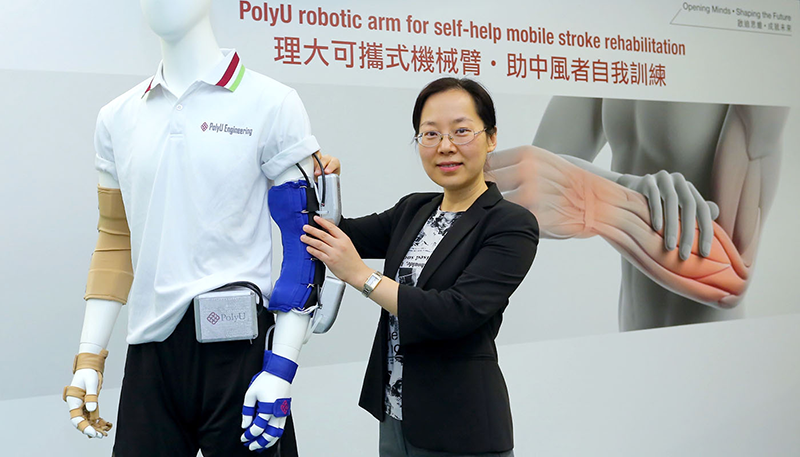The Hong Kong Polytechnic University (PolyU) has developed a robotic arm to facilitate self-help and upper-limb mobile rehabilitation for stroke patients. Using the lightweight device, stroke patients can engage in intensive and effective self-help rehabilitation exercise even after they’re discharged from the hospital.
Dubbed “mobile exo-neuro-musculo-skeleton,” it’s the first-of-its-kind integration of exo-skeleton, soft robot and exo-nerve stimulation technologies. The novel device, developed by Dr. Hu Xiaoling and her research team in the Department of Biomedical Engineering (BME) of PolyU, was inspired by the feedback of many stroke patients who were discharged from hospital.
This compact, lightweight device is fast in response and requires minimal power supply, making it suitable for use in both indoor and outdoor environment, says a press release.
Approximately 15 million people worldwide suffer a stroke each year. Stroke is also the third leading cause of disability worldwide. In Hong Kong alone, there are about 25,000 new incidences of stroke annually in recent years. Research studies have proven that intensive, repeated and long-term rehabilitation training are crucial for enhancing the physical mobility of stroke patients, thus help alleviating post-stroke symptoms such as disability.
Related These Amazing Exoskeletons Are Changing the Lives of Many
The “mobile exo-neuro-musculo-skeleton” features lightweight design (up to 300g for wearable upper limb components, which are fit for different functional training needs), low power demand (12V rechargeable battery supply for 4-hour continuous use), and sportswear features. The robotic arm thus provides a flexible, self-help, easy-to-use, mobile tool for patients to supplement their rehabilitation sessions at the clinic. The innovative training option can effectively enhance the rehabilitation progress.
“We are confident that with our mobile exo-neuro-musculo-skeleton, stroke patients can conduct rehabilitation training anytime and anywhere, turning the training into part of their daily activities. We hope such flexible self-help training can well supplement traditional outpatient rehabilitation services, helping stroke patients achieve a much better rehabilitation progress,” says Dr. Xiaoling. Her team anticipates that the robotic arm can be commercialized in two years.
Mobile Exo-Neuro-Musculo-Skeleton Vs. Exo-Skeleton and Soft Robots
Conventional exo-skeleton structure is primarily made from orthotic materials such as metal and plastic, simulating external bones of the wearer. Although it is compact in size, it is heavy and uncomfortable to wear. Soft robots, on the other hand are made of air-filled or liquid-filled pipes to simulate one’s external muscles; while it is light in weight, it’s very bulky in size. Both types of structures demand high electrical power for driving motors or pumps, thus it is not convenient for patients to use them outside hospitals or rehabilitation centers. Combining the advantages of both structural designs, the BME innovative robotic arm is light in weight, compact in size, fast in response and demands minimal power supply, therefore it is suitable for use in both indoor and outdoor environment.
Related Designing Exoskeletons to Interact with Humans
Study
An initial trial of the robotic arm on 10 stroke patients showed better muscle coordination, wrist and finger functions, and lower muscle spasticity in all patients after they completed 20 two-hour training sessions. Further clinical trials will be carried out in collaboration with hospitals and clinics.













